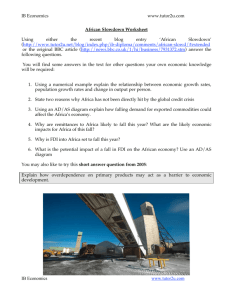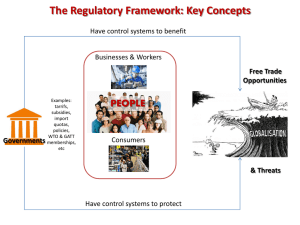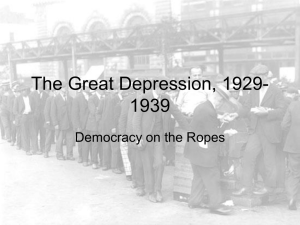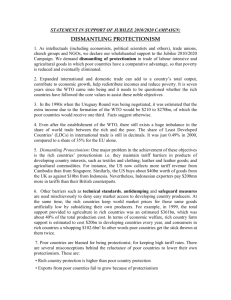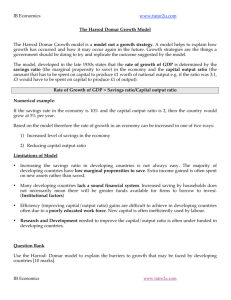A2 Economics - Free Exam Papers
advertisement
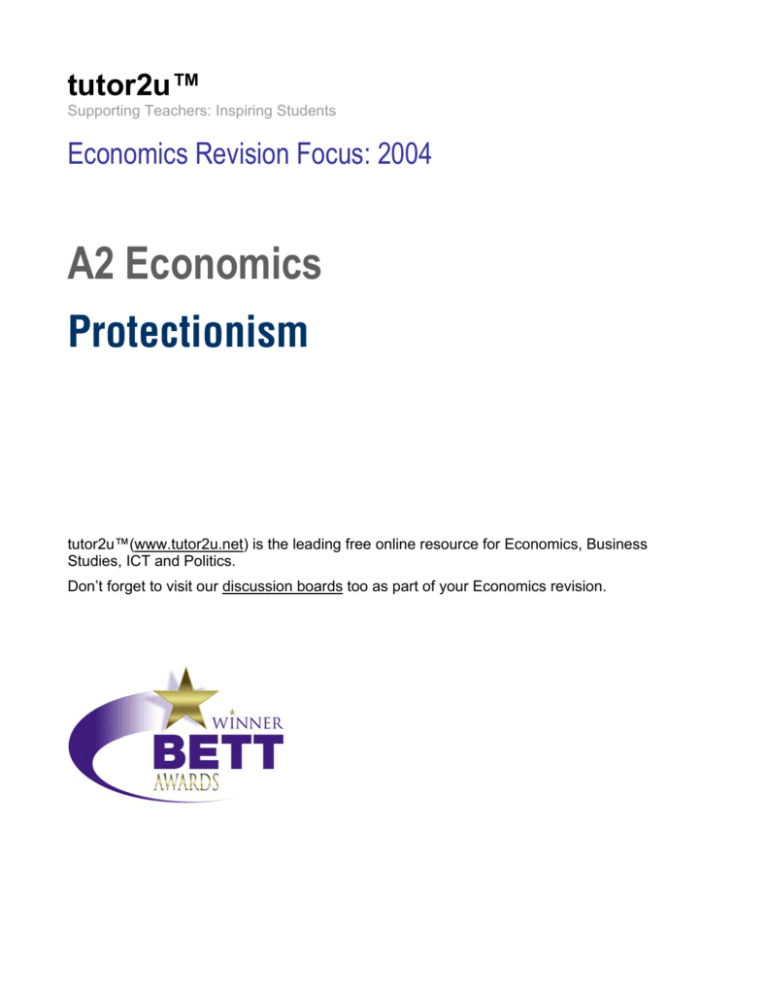
tutor2u™ Supporting Teachers: Inspiring Students Economics Revision Focus: 2004 A2 Economics Protectionism tutor2u™(www.tutor2u.net) is the leading free online resource for Economics, Business Studies, ICT and Politics. Don’t forget to visit our discussion boards too as part of your Economics revision. tutor2u™ Supporting Teachers: Inspiring Students Page 2 of 6 Protectionism Revision Focus on Protectionism (A2) A2 Syllabus Requirements Candidates should understand the causes and consequences of protectionism. They should understand the effects of different protectionist policies such as tariffs and quotas. Protectionism should be put into a European context with an understanding shown of the EU as a customs union. Protectionism represents any attempt by a government to impose restrictions on trade in goods and services between countries Tariffs - import taxes Quotas - quantitative limits on the level of imports allowed Voluntary Export Restraint Arrangements – where two countries make a bi-lateral agreement to limit the volume of their exports to one another over an agreed period of time Embargoes - a total ban on imported goods Subsidies - a government payment to encourage domestic production by lowering their costs Import licensing - governments grants importers the license to import goods Exchange controls - limiting the amount of foreign exchange that can move between countries Tariffs A tariff raises the price of imported products and causes a contraction in demand and an expansion in domestic supply. The net effect is that the volume of imports is reduced and the government received some tax revenue from the tariff. www.tutor2u.net : The Home of Economics on the Internet tutor2u™ Supporting Teachers: Inspiring Students Protectionism Page 3 of 6 Price Domestic Supply Revenue from Tariff Pw + Tariff Pw + T World Price Pw M Domestic Demand Qs Qs2 Qd2 Qd Output (Q) Average import tariffs between OECD countries are around 3 per cent; but tariff peaks reach 506 per cent in the EU, and 350 per cent in the US. The highest tariffs are typically levied on goods from the developing world. Among non-agricultural products, the EU has 135 tariff lines over 15 per cent and about 600 tariff lines between 10 and 15 percent, many in labour-intensive products in which developing countries have a comparative advantage. The USA has 230 tariff lines above 15 per cent, and Australia has nearly 800. Import Quotas The Government might seek to limit the level of imports through a quota. Examples of quotas are found in the textile industry under the terms of the Multi-Fibre Agreement. Quotas can be in terms of volume (number of units imported) or value (value of imports) permitted Administrative Barriers Countries can make it difficult for firms to import by imposing restrictions and being 'deliberately' bureaucratic. These trade barriers range from stringent safety and specification checks to extensive holdups in the customs arrangements. A good example is the quality standards imposed by the EU on imports of dairy products. Preferential Government Procurement Policies and State Aid Free trade can be limited by preferential behaviour by the government when allocating major spending projects that favour domestic rather than overseas suppliers. These procurement policies run against the principle of free trade within the EU Single Market – but they remain a feature of the trade policies of many developed countries within Western Europe. Good examples include the award of contracts to suppliers of defence equipment or construction companies involved in building transport infrastructure projects. www.tutor2u.net : The Home of Economics on the Internet tutor2u™ Supporting Teachers: Inspiring Students Page 4 of 6 Protectionism The use of financial aid from the state can also distort the free trade of goods and services between nations, for example the use of subsidies to a domestic coal or steel industry, or the widely criticized use of export refunds (subsidies) to European farmers under the Common Agricultural Policy (CAP) which is criticized for damaging the profits and incomes of farmers in developing countries. Economic justifications for protectionism Infant Industry Argument Certain industries possess a potential (latent) comparative advantage but have not yet exploited the potential economies of scale. Short-term protection from established foreign competition allows the ‘infant industry’ to develop its comparative advantage. At this point the trade protection could be relaxed, leaving the industry to trade freely on the international market. The danger of this form of protection is that the industry will never achieve full efficiency. The short-term protectionist measures often start to appear permanent. Protection – a reaction against “import dumping” If a company exports a product at a price lower than the price it normally charges on its own home market, it is said to be “dumping” the product. In the short term, consumers benefit from the low prices of the foreign goods, but in the longer term, persistent undercutting of domestic prices will force the domestic industry out of business and allow the foreign firm to establish itself as a monopoly. Once this is achieved the foreign owned monopoly is free to increase its prices and exploit the consumer. Therefore protection, via tariffs on 'dumped' goods can be justified to prevent the long-term exploitation of the consumer. The World Trade Organisation www.wto.org allows a government to act against dumping where there is genuine ‘material’ injury to the competing domestic industry. In order to do that the government has to be able to show that dumping is taking place, calculate the extent of dumping (how much lower the export price is compared to the exporter’s home market price), and show that the dumping is causing injury. Usually an ‘anti-dumping action’ means charging extra import duty on the particular product from the particular exporting country in order to bring its price closer to the “normal value”. Externalities, Market Failure and Import Controls Protectionism can also be used to take account of externalities and dealing with de-merit goods. Goods such as alcohol, tobacco and narcotic drugs have adverse social effects and are termed de-merit goods. Protectionism can safeguard society from the importation of these goods, by imposing high tariff barriers or by banning the importation of the good altogether. Non-Economic Reasons Countries may wish not to over-specialise in the goods in which they possess a comparative advantage. One danger of over-specialisation is that unemployment may rise quickly if an industry moves into structural decline as new international competition emerges at lower costs The government may also wish to protect employment in strategic industries, although clearly value judgements are involved in determining what constitutes a strategic sector. The recent trade dispute arising from the decision by the United States to introduce a tariff on steel imports is linked to this objective. The US steel tariff was declared unlawful by the WTO in July 2003 and eventually the United States was pressurized into withdrawing these tariffs in the late autumn of 2003. www.tutor2u.net : The Home of Economics on the Internet tutor2u™ Supporting Teachers: Inspiring Students Page 5 of 6 Protectionism Economic Arguments against Import Controls According to Professor Jagdish Bhagwati, “the fact that trade protection hurts the economy of the country that imposes it is one of the oldest but still most startling insights economics has to offer.” The folly of protection has been confirmed by a range of studies from around the world. These indicate that that it has brought few benefits but imposed substantial costs. 1. Market distortion: Protection has proved an ineffective and costly means of sustaining employment. a. Higher prices for consumers: Trade barriers in the form of tariffs push up the prices faced by consumers and insulate inefficient sectors from competition. They penalise foreign producers and encourage the inefficient allocation of resources both domestically and globally. In general terms, import controls impose costs on society that would not exist if there was completely free trade in goods and services b. Reduction in market access for producers: Export subsidies, depressing world prices and making them more volatile while depriving efficient farmers of access to the world market. This is a major criticism of the EU common agricultural policy. In 2002 the EU sugar regime lowered the value of Brazil, Thailand and South Africa’s sugar exports by over $700 million – countries where nearly 70 million people survive on less than $2 a day. 2. Loss of economic welfare: Tariffs create a deadweight loss of consumer and producer surplus arising from a loss of allocative efficiency. Welfare is reduced through higher prices and restricted consumer choice. 3. Production inefficiencies: Firms that are protected from competition have little incentive to reduce production costs. Governments must consider these disadvantages carefully 4. Trade wars: There is the danger that one country imposing import controls will lead to “retaliatory action” by another leading to a decrease in the volume of world trade. Retaliatory actions increase the costs of importing new technologies 5. Negative multiplier effects: If one country imposes trade restrictions on another, the resultant decrease in total trade will have a negative multiplier effect affecting many more countries because exports are an injection of demand into the global circular flow of income. The negative multiplier effects are more pronounced when trade disputes boil over and lead to retaliation. The diagram below shows the welfare consequences of imposing an import tariff www.tutor2u.net : The Home of Economics on the Internet tutor2u™ Supporting Teachers: Inspiring Students Protectionism Page 6 of 6 Price Domestic Supply Deadweight loss of economic welfare from the tariff Revenue from Tariff Pw + Tariff Pw + T World Price Pw M Domestic Demand Qs Qs2 Qd2 Qd Output (Q) In a new study of the benefits of global trade and investment published in May 2004, the UK Department of Trade of Industry outlined their opposition to import controls (protectionism) Protectionism imposes a double burden on tax payers and consumers. In the case of European agriculture, the cost to tax payers is about €50 billion a year, plus around €50 billion a year to consumers via artificially high food prices – together the equivalent of over £800 a year on the annual food budget of an average family of four. Furthermore huge distortions in international agriculture markets prevent the world’s poorest countries from trading in the products they are best able to produce. Continuing barriers to trade are costing the global economy around $500 billion a year in lost income. Protectionist policies rarely achieve their aims. They can be costly to administer and they nearly always provide domestic suppliers with a protectionist shield that encourages inefficiencies leading to higher costs. Protectionism is a ‘second best’ approach to correcting for a country’s balance of payments problem or the fear of rising structural unemployment. And import controls go against the principles of free trade enshrined in the theories of comparative advantage. In this sense, import controls can be seen as examples of government failure arising from intervention in markets. www.tutor2u.net : The Home of Economics on the Internet
